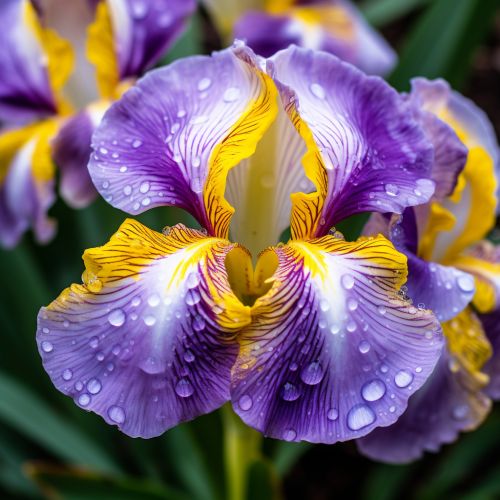Iris unguicularis
Taxonomy and Naming
The Iris unguicularis, also known as the Algerian iris, is a species of flowering plant in the Iris family, Iridaceae. The scientific name unguicularis is derived from the Latin word 'unguis', meaning 'nail' or 'claw', referring to the claw-like shape of the flower's petals.
Description
The Iris unguicularis is a rhizomatous perennial, growing from a thick, creeping rhizome. The plant typically reaches a height of 30–60 cm (12–24 in), with a similar spread. The leaves are evergreen, linear, and grass-like, measuring up to 40 cm (16 in) long and 2 cm (0.8 in) wide.


The flowers of the Iris unguicularis are particularly notable. They are large, typically 7–8 cm (2.8–3.1 in) in diameter, and are borne singly on slender, leafless stems. The flowers are usually a deep lavender-blue color, although variations in shade can occur, ranging from pale lilac to a rich, dark purple. Each flower has six petals: three upright 'standards' and three drooping 'falls'. The falls are marked with a central yellow or white crest, which is often veined with purple.
Distribution and Habitat
The Iris unguicularis is native to the Mediterranean region, particularly Algeria and Greece. It is found in rocky, scrubby areas, often on limestone slopes. The plant prefers well-drained soil and a sunny position, and is highly tolerant of drought, making it well-suited to Mediterranean climates.
Cultivation and Uses
The Iris unguicularis is widely cultivated as an ornamental plant, prized for its vibrant, winter-blooming flowers. It is particularly valued in gardens for its ability to produce flowers during the winter months, when few other plants are in bloom. The plant is typically grown in borders or rock gardens, and is also suitable for cultivation in containers.
The Iris unguicularis requires minimal care once established. It prefers a sunny position and well-drained soil, and is tolerant of poor, dry soils. The plant is drought-tolerant and requires little watering, making it a good choice for water-efficient gardens. It is also resistant to most pests and diseases.
Propagation
The Iris unguicularis can be propagated by division or from seed. Division is typically carried out in late summer, after flowering has finished. The rhizomes should be divided and replanted immediately to prevent them from drying out. Seed can be sown in pots in a cold frame in autumn, and the seedlings transplanted to their final positions in spring.
Conservation Status
The Iris unguicularis is not currently considered to be at risk of extinction. However, like all wild species, it may be threatened by habitat loss due to human activities such as agriculture and urban development.
